The Impact of Dissolved Biochar on Oxidative Stress and Its Effect on the Virulence of Steinernema feltiae: Implications for Biocontrol Efficiency
Abstract
1. Introduction
2. Materials and Methods
2.1. Preparation and Characterization of Dissolved Biochar
2.2. Measurement of Virulence in EPNs Post-Infection Nematodes Treated with DBC
2.2.1. Acquisition of Steinernema feltiae and Galleria mellonella
2.2.2. The Mortality Rate of EPNs During the Infective Stage After DBC Treatment
2.2.3. CAT/SOD/ROS Test
2.2.4. The Virulence of EPNs During the Infective Stage After DBC Treatment
2.3. Transcriptome Sequencing
2.4. Statistical Analysis
3. Results
3.1. Characterization of Dissolved Biochar
3.2. DBC Effect on ROS and Antioxidant Enzyme Activity in S. feltiae During Infection
3.3. DBC Effect on S. feltiae Virulence During Infection
3.4. Statistical Analysis of Differentially Expressed Genes
3.5. Functional Enrichment and Pathway Analysis of DBC-Exposed Steinernema feltiae
4. Discussion
4.1. DBC-Induced Oxidative Stress and Its Impact on EPNs Antioxidant Defense System
4.2. Mechanisms of EPN Virulence Reduction and Adaptation via DBC Regulation
5. Conclusions
Supplementary Materials
Author Contributions
Funding
Institutional Review Board Statement
Data Availability Statement
Acknowledgments
Conflicts of Interest
References
- El-Naggar, A.; El-Naggar, A.H.; Shaheen, S.M.; Sarkar, B.; Chang, S.X.; Tsang, D.C.W.; Rinklebe, J.; Ok, Y.S. Biochar Composition-Dependent Impacts on Soil Nutrient Release, Carbon Mineralization, and Potential Environmental Risk: A Review. J. Environ. Manag. 2019, 241, 458–467. [Google Scholar] [CrossRef]
- Tomczyk, A.; Sokolowska, Z.; Boguta, P. Biochar Physicochemical Properties: Pyrolysis Temperature and Feedstock Kind Effects. Rev. Environ. Sci. Bio-Technol. 2020, 19, 191–215. [Google Scholar] [CrossRef]
- Lehmann, J.; Joseph, S. Biochar for Environmental Management: Science, Technology and Implementation, 2nd ed.; Earthscan from Routledge: Oxfordshire, UK, 2015. [Google Scholar]
- Kumar, S.; Kaushik, G.; Masto, R.E. Evaluation of the Fuel Value and Soil Application Potential of the Cadmium Contaminated Biochar Obtained after Water Treatment. Solid Fuel Chem. 2020, 54, 411–417. [Google Scholar] [CrossRef]
- Lian, F.; Xing, B.S. From Bulk to Nano: Formation, Features, and Functions of Nano-Black Carbon in Biogeochemical Processes. Environ. Sci. Technol. 2024, 58, 15910–15925. [Google Scholar] [CrossRef]
- Sani, M.N.H.; Amin, M.; Siddique, A.; Nasif, S.O.; Ghaley, B.B.; Ge, L.Y.; Wang, F.; Yong, J.W.H. Waste-Derived Nanobiochar: A New Avenue Towards Sustainable Agriculture, Environment, and Circular Bioeconomy. Sci. Total Environ. 2023, 905, 166881. [Google Scholar] [CrossRef]
- Mukherjee, S.; Kumar, M. Cycling of Black Carbon and Black Nitrogen in the Hydro-Geosphere: Insights on the Paradigm, Pathway, and Processes. Sci. Total Environ. 2021, 770, 144711. [Google Scholar] [CrossRef] [PubMed]
- Hameed, R.; Li, G.L.; Son, Y.; Fang, H.J.; Kim, T.; Zhu, C.D.; Feng, Y.F.; Zhang, L.H.; Abbas, A.; Zhao, X.; et al. Structural Characteristics of Dissolved Black Carbon and Its Interactions with Organic and Inorganic Contaminants: A Critical Review. Sci. Total Environ. 2023, 872, 162210. [Google Scholar] [CrossRef]
- Ma, C.; Zhang, R.J.; He, Z.; Su, P.J.; Wang, L.K.; Yao, Y.Z.; Zhang, X.J.; Liu, X.Y.; Yang, F.S. Biochar Alters the Soil Fauna Functional Traits and Community Diversity: A Quantitative and Cascading Perspective. J. Hazard. Mater. 2024, 477, 135302. [Google Scholar] [CrossRef]
- Abbas, Q.; Yousaf, B.; Ullah, H.; Ali, M.U.; Ok, Y.S.; Rinklebe, J. Environmental Transformation and Nano-Toxicity of Engineered Nano-Particles (ENPs) in Aquatic and Terrestrial Organisms. Crit. Rev. Environ. Sci. Technol. 2020, 50, 2523–2581. [Google Scholar] [CrossRef]
- Zhang, Y.; Han, M.; Si, X.H.; Bai, L.L.; Zhang, C.X.; Quan, X. Toxicity of Biochar Influenced by Aging Time and Environmental Factors. Chemosphere 2022, 298, 134262. [Google Scholar] [CrossRef]
- Bongers, T.; Ferris, H. Nematode Community Structure as a Bioindicator in Environmental Monitoring. Trends Ecol. Evol. 1999, 14, 224–228. [Google Scholar] [CrossRef] [PubMed]
- Lu, Q.F.; Liu, T.T.; Wang, N.Q.; Dou, Z.C.; Wang, K.G.; Zuo, Y.M. A Review of Soil Nematodes as Biological Indicators for the Assessment of Soil Health. Front. Agric. Sci. Eng. 2020, 7, 275–281. [Google Scholar] [CrossRef]
- Liu, X.D.; Zhang, D.X.; Li, H.X.; Qi, X.X.; Gao, Y.; Zhang, Y.B.; Han, Y.L.; Jiang, Y.; Li, H. Soil Nematode Community and Crop Productivity in Response to 5-Year Biochar and Manure Addition to Yellow Cinnamon Soil. BMC Ecol. 2020, 20, 39. [Google Scholar] [CrossRef] [PubMed]
- Ikram, M.; Singh, S.; Bano, N.; Alahmadi, T.A.; Shariq, M.; Siddiqui, M.A.; Islam, J. Biochar and Oil Cakes Act as Antagonists Towards Meloidogyne incognita in Tomato: A Sustainable Approach. Plant Stress 2024, 11, 100320. [Google Scholar] [CrossRef]
- Li, J.; Chen, Y.X.; Zhang, G.L.; Ruan, W.B.; Shan, S.J.; Lai, X.; Yang, D.L.; Yu, Z.G. Integration of Behavioural Tests and Transcriptome Sequencing of C. elegans Reveals How the Nematode Responds to Peanut Shell Biochar Amendment. Sci. Total Environ. 2020, 707, 136024. [Google Scholar] [CrossRef]
- Huang, W.K.; Ji, H.L.; Gheysen, G.; Debode, J.; Kyndt, T. Biochar-Amended Potting Medium Reduces the Susceptibility of Rice to Root-Knot Nematode Infections. BMC Plant Biol. 2015, 15, 267. [Google Scholar] [CrossRef]
- Boyle, S.; Kakouli-Duarte, T. The Behaviour of the Nematode, Steinernema feltiae (Nematoda: Steinernematidae) in Sand Contaminated with the Industrial Pollutant Chromium VI. Ecotoxicology 2018, 27, 590–604. [Google Scholar] [CrossRef]
- Askary, T.H.; Bhat, A.H.; Ahmad, M.J.; Chaubey, A.K.; Spiridonov, S.E. Steinernema feltiae (Rhabditida: Steinernematidae) from Hilly Areas of Kashmir Valley, India with a Note on Its Geographical Distribution. Russ. J. Nematol. 2020, 28, 99–106. [Google Scholar] [CrossRef]
- Bal, H.K.; Acosta, N.; Cheng, Z.Q.; Grewal, P.S.; Hoy, C.W. Effect of Habitat and Soil Management on Dispersal and Distribution Patterns of Entomopathogenic Nematodes. Appl. Soil Ecol. 2017, 121, 48–59. [Google Scholar] [CrossRef]
- Herren, G.L.; Binnemans, I.; Joos, L.; Viaene, N.; Ehlers, R.U.; Vandecasteele, B.; Bert, W.; Steel, H. Compost as a Carrier Medium for Entomopathogenic Nematodes—The Influence of Compost Maturity on Their Virulence and Survival. Biol. Control 2018, 125, 29–38. [Google Scholar] [CrossRef]
- Lu, D.H.; Macchietto, M.; Chang, D.; Barros, M.M.; Baldwin, J.; Mortazavi, A.; Dillman, A.R. Activated Entomopathogenic Nematode Infective Juveniles Release Lethal Venom Proteins. PLoS Pathog. 2017, 13, e1006302. [Google Scholar] [CrossRef]
- Maushe, D.; Ogi, V.; Divakaran, K.; Mogena, A.M.V.; Himmighofen, P.A.; Machado, R.A.R.; Towbin, B.D.; Ehlers, R.U.; Molina, C.; Parisod, C.; et al. Stress Tolerance in Entomopathogenic Nematodes: Engineering Superior Nematodes for Precision Agriculture. J. Invertebr. Pathol. 2023, 199, 107953. [Google Scholar] [CrossRef]
- Eleftherianos, I.; Shokal, U.; Yadav, S.; Kenney, E.; Maldonado, T. Insect Immunity to Entomopathogenic Nematodes and Their Mutualistic Bacteria. In Molecular Biology of Photorhabdus Bacteria; Ffrench-Constant, R.H., Ed.; Springer International Publishing AG: Cham, Switzerland, 2017; pp. 123–156. [Google Scholar]
- Yaman, E.; Ulu, T.C.; Özbay, N. Characterization of Different Biochars and Their Impacts on Infectivity of Entomopathogenic Nematode Heterorhabditis bacteriophora. Biomass Convers. Biorefinery 2023, 13, 10177–10190. [Google Scholar] [CrossRef]
- Bhat, A.H.; Chaubey, A.K.; Askary, T.H. Global Distribution of Entomopathogenic Nematodes, Steinernema and Heterorhabditis. Egypt. J. Biol. Pest Control. 2020, 30, 31. [Google Scholar] [CrossRef]
- Abd-Elgawad, M.M.M. Xenorhabdus spp.: An Overview of the Useful Facets of Mutualistic Bacteria of Entomopathogenic Nematodes. Life 2022, 12, 1360. [Google Scholar] [CrossRef]
- Awori, R.M. Nematophilic Bacteria Associated with Entomopathogenic Nematodes and Drug Development of Their Biomolecules. Front. Microbiol. 2022, 13, 993688. [Google Scholar] [CrossRef]
- Khan, H.A.; Naqvi, S.R.; Mehran, M.T.; Khoja, A.H.; Niazi, M.B.K.; Juchelková, D.; Atabani, A. A Performance Evaluation Study of Nano-Biochar as a Potential Slow-Release Nano-Fertilizer from Wheat Straw Residue for Sustainable Agriculture. Chemosphere 2021, 285, 131382. [Google Scholar] [CrossRef]
- Li, R.; Wang, B.; Niu, A.P.; Cheng, N.; Chen, M.; Zhang, X.Y.; Yu, Z.B.; Wang, S.S. Application of Biochar Immobilized Microorganisms for Pollutants Removal from Wastewater: A Review. Sci. Total Environ. 2022, 837, 155563. [Google Scholar] [CrossRef]
- Mod, B.; Baskar, A.V.; Bahadur, R.; Tavakkoli, E.; Van Zwieten, L.; Singh, G.; Vinu, A. From Cane to Nano: Advanced Nanomaterials Derived from Sugarcane Products with Insights into Their Synthesis and Applications. Sci. Technol. Adv. Mater. 2024, 25, 2393568. [Google Scholar] [CrossRef]
- Li, M.G.; Ha, B.; Li, Y.C.; Vrieling, K.; Fu, Z.; Yu, Q.L.; Rasmann, S.; Wei, X.Q.; Ruan, W.B. Toxicological Impacts of Microplastics on Virulence, Reproduction, and Physiological Processes of Entomopathogenic Nematodes. Ecotoxicol. Environ. Saf. 2024, 273, 116153. [Google Scholar] [CrossRef]
- Kim, D.; Landmead, B.; Salzberg, S.L. HISAT: A Fast Spliced Aligner with Low Memory Requirements. Nat. Methods 2015, 12, 357–360. [Google Scholar] [CrossRef]
- Pertea, M.; Pertea, G.M.; Antonescu, C.M.; Chang, T.C.; Mendell, J.T.; Salzberg, S.L. StringTie Enables Improved Reconstruction of a Transcriptome from RNA-seq Reads. Nat. Biotechnol. 2015, 33, 290–295. [Google Scholar] [CrossRef]
- Li, B.; Dewey, C.N. RSEM: Accurate Transcript Quantification from RNA-Seq Data with or without a Reference Genome. BMC Bioinformatics 2011, 12, 323. [Google Scholar] [CrossRef]
- Love, M.I.; Huber, W.; Anders, S. Moderated Estimation of Fold Change and Dispersion for RNA-seq Data with DESeq2. Genome Biol. 2014, 15, 550. [Google Scholar] [CrossRef]
- Wang, L.; Feng, Z.; Wang, X.; Wang, X.; Zhang, X. DEGseq: An R Package for Identifying Differentially Expressed Genes from RNA-seq Data. Bioinformatics 2009, 26, 136–138. [Google Scholar] [CrossRef] [PubMed]
- Smith, C.R.; Hatcher, P.G.; Kumar, S.; Lee, J.W. Investigation into the Sources of Biochar Water-Soluble Organic Compounds and Their Potential Toxicity on Aquatic Microorganisms. ACS Sustain. Chem. Eng. 2016, 4, 2550–2558. [Google Scholar] [CrossRef]
- Du, Z.L.; Hu, A.B.; Wang, Q.D.; Ai, J.; Zhang, W.J.; Liang, Y.; Cao, M.X.; Wu, H.J.; Wang, D.S. Molecular Composition and Biotoxicity Effects of Dissolved Organic Matters in Sludge-Based Carbon: Effects of Pyrolysis Temperature. J. Hazard. Mater. 2022, 424, 127346. [Google Scholar] [CrossRef]
- Liu, Y.Z.; Zhou, S.S.; Fu, Y.; Sun, X.M.; Li, T.J.; Yang, C.H. Characterization of Dissolved Organic Matter in Biochar Derived from Various Macroalgae (Phaeophyta, Rhodophyta, and Chlorophyta): Effects of Pyrolysis Temperature and Extraction Solution pH. Sci. Total Environ. 2023, 869, 161786. [Google Scholar] [CrossRef]
- Zhao, Y.; Li, X.; Nan, J. Systematic Assessment of the Ecotoxicological Effects and Mechanisms of Biochar-Derived Dissolved Organic Matter (DOM) on the Earthworm Eisenia fetida. Environ. Res. 2023, 236, 116855. [Google Scholar] [CrossRef]
- Qu, C.C.; Qian, S.F.; Chen, L.; Guan, Y.; Zheng, L.; Liu, S.H.; Chen, W.L.; Cai, P.; Huang, Q.Y. Size-Dependent Bacterial Toxicity of Hematite Particles. Environ. Sci. Technol. 2019, 53, 8147–8156. [Google Scholar] [CrossRef]
- Alfei, S.; Pandoli, O.G. Biochar-Derived Persistent Free Radicals: A Plethora of Environmental Applications in a Light and Shadows Scenario. Toxics 2024, 12, 245. [Google Scholar] [CrossRef] [PubMed]
- Odinga, E.S.; Waigi, M.G.; Gudda, F.O.; Wang, J.; Yang, B.; Hu, X.J.; Li, S.Y.; Gao, Y.Z. Occurrence, Formation, Environmental Fate and Risks of Environmentally Persistent Free Radicals in Biochars. Environ. Int. 2020, 134, 105172. [Google Scholar] [CrossRef] [PubMed]
- Matés, J.M. Erratum to ‘Effects of antioxidant enzymes in the molecular control of reactive oxygen species toxicology’: [Toxicology 153 (2000) 83–104]. Toxicology 2001, 163, 219. [Google Scholar] [CrossRef]
- Signorella, S.; Palopoli, C.; Ledesma, G. Rationally Designed Mimics of Antioxidant Manganoenzymes: Role of Structural Features in the Quest for Catalysts with Catalase and Superoxide Dismutase Activity. Coord. Chem. Rev. 2018, 365, 75–102. [Google Scholar] [CrossRef]
- Limón-Pacheco, J.; Gonsebatt, M.E. The Role of Antioxidants and Antioxidant-Related Enzymes in Protective Responses to Environmentally Induced Oxidative Stress. Mutat. Res. Genet. Toxicol. Environ. Mutagen 2009, 674, 137–147. [Google Scholar] [CrossRef]
- Gu, S.G.; Lian, F.; Han, Y.R.; Wang, Z.Y.; Xing, B.S. Effect of Root Exudates on the Release, Surface Property, Colloidal Stability, and Phytotoxicity of Dissolved Black Carbon. Ecotoxicol. Environ. Saf. 2022, 239, 113687. [Google Scholar] [CrossRef]
- Selkirk, M.E.; Smith, V.P.; Thomas, G.R.; Gounaris, K. Resistance of Filarial Nematode Parasites to Oxidative Stress. Int. J. Parasitol. 1998, 28, 1315–1332. [Google Scholar] [CrossRef]
- Lai, Y.; Gao, F.F.; Ge, R.T.; Liu, R.; Ma, S.M.; Liu, X.D. Metal Ions Overloading and Cell Death. Cell Biol. Toxicol. 2024, 40, 72. [Google Scholar] [CrossRef]
- Chen, Y.; Wang, X.; Li, J.; Wang, Z.; Song, T.; Lai, X.; Zhang, G.; Ruan, W. The effects of different biochars on Caenorhabditis elegans and the underlying transcriptomic mechanisms. PLoS ONE 2023, 18, e0284348. [Google Scholar] [CrossRef]
- Budai, A.; Rasse, D.P.; Lagomarsino, A.; Lerch, T.Z.; Paruch, L. Biochar persistence, priming and microbial responses to pyrolysis temperature series. Biol. Fertil. Soils 2016, 52, 749–761. [Google Scholar] [CrossRef]
- Maleita, C.; Esteves, I.; Braga, M.E.M.; Figueiredo, J.; Gaspar, M.C.; Abrantes, I.; de Sousa, H.C. Juglone and 1,4-Naphthoquinone—Promising Nematicides for Sustainable Control of the Root Knot Nematode Meloidogyne luci. Front. Plant Sci. 2022, 13, 867803. [Google Scholar] [CrossRef]
- Devi, G. Entomopathogenic Nematodes and Their Symbiotic Bacteria: Microorganism-Host Interactions: A Review. Int. J. Environ. Clim. Change 2023, 13, 3443–3455. [Google Scholar] [CrossRef]
- Hasan, M.S.; Lin, C.J.; Marhavy, P.; Kyndt, T.; Siddique, S. Redox Signalling in Plant-Nematode Interactions: Insights into Molecular Crosstalk and Defense Mechanisms. Plant Cell Environ. 2024, 47, 2811–2820. [Google Scholar] [CrossRef] [PubMed]
- Shi, S.Y.; Wang, G.; Wang, Y.D.; Zhang, L.G.; Zhang, L.X. Protective Effect of Nitric Oxide against Oxidative Stress under Ultraviolet-B Radiation. Nitric Oxide-Biol. Chem. 2005, 13, 1–9. [Google Scholar] [CrossRef]
- Jiang, Y.; Huang, M.H.; Qin, R.F.; Jiang, D.; Chang, D.D.; Xie, Y.F.; Li, C.J.; Wang, C.L. Full-Length Transcriptome Analysis of Soybean Cyst Nematode (Heterodera glycines) Reveals an Association of Behaviors in Response to Attractive pH and Salt Solutions with Activation of Transmembrane Receptors, Ion Channels, and Ca2+ Transporters. J. Agric. Food Chem. 2023, 71, 8778–8796. [Google Scholar] [CrossRef]
- Gillet, F.X.; Bournaud, C.; de Souza, J.D.A.; Grossi-de-Sa, M.F. Plant-Parasitic Nematodes: Towards Understanding Molecular Players in Stress Responses. Ann. Bot. 2017, 119, 775–789. [Google Scholar] [CrossRef]
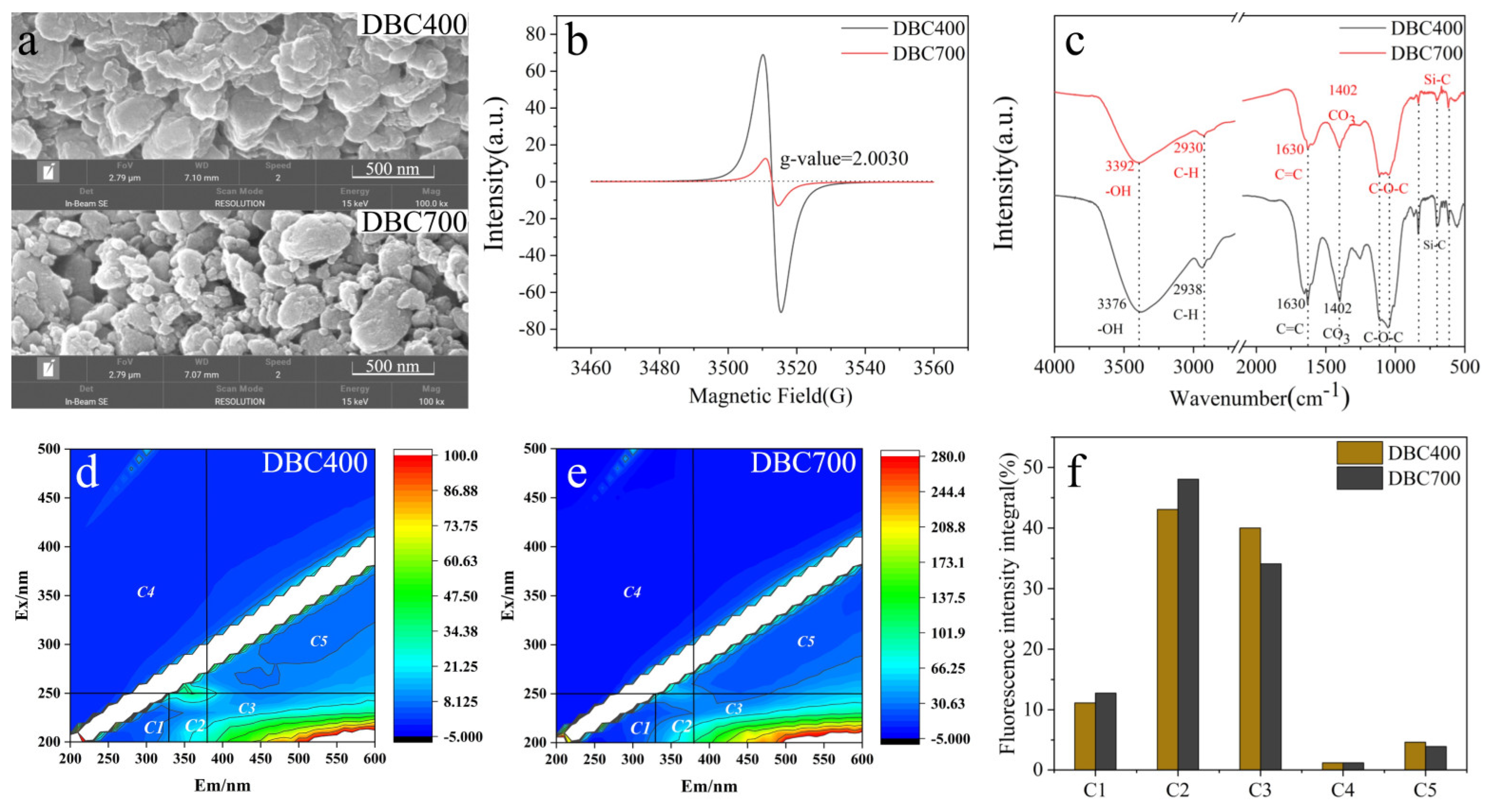


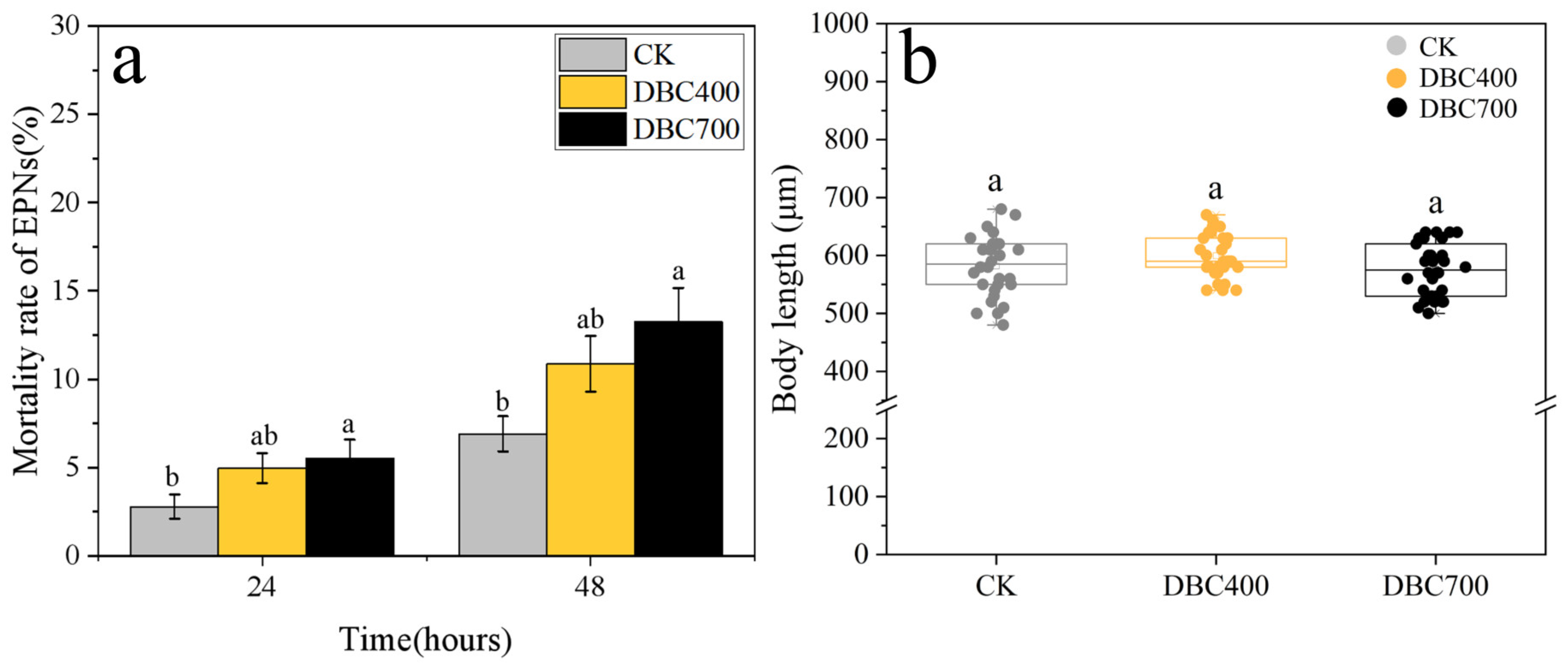
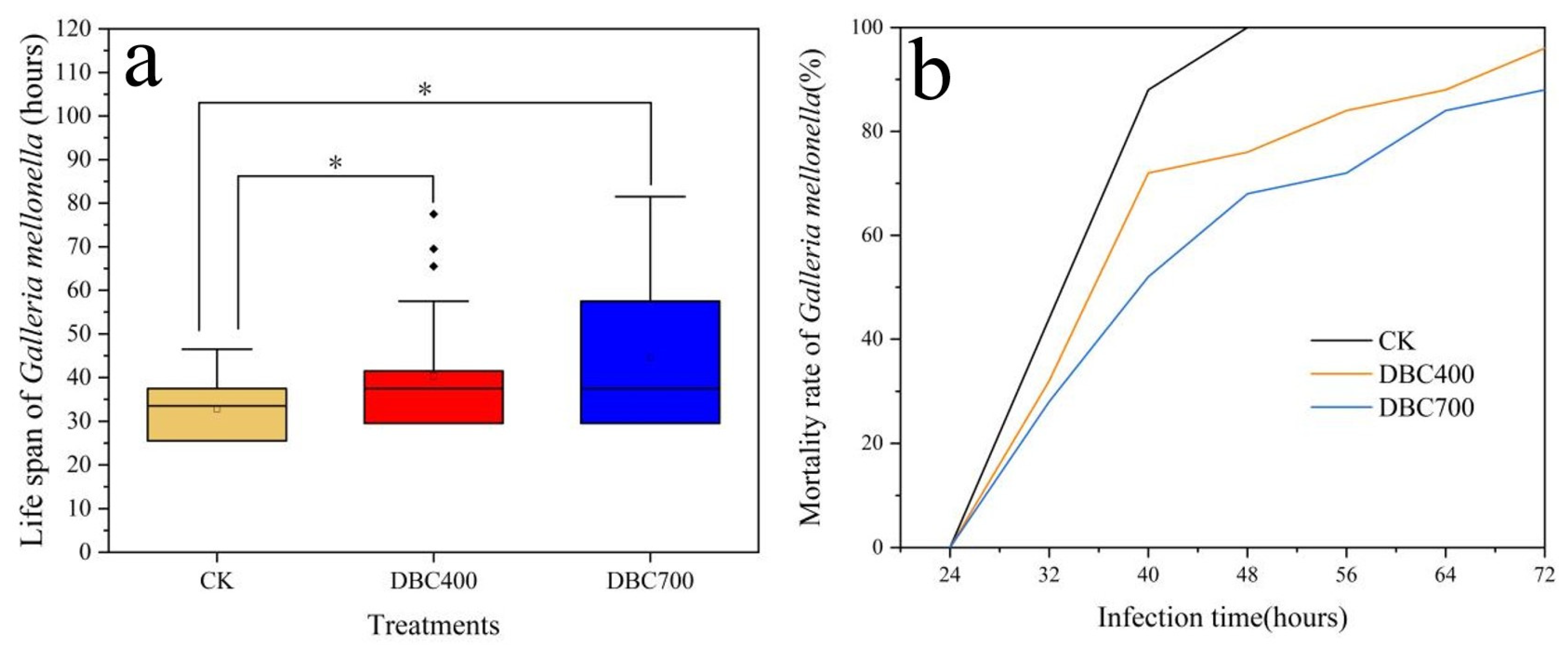

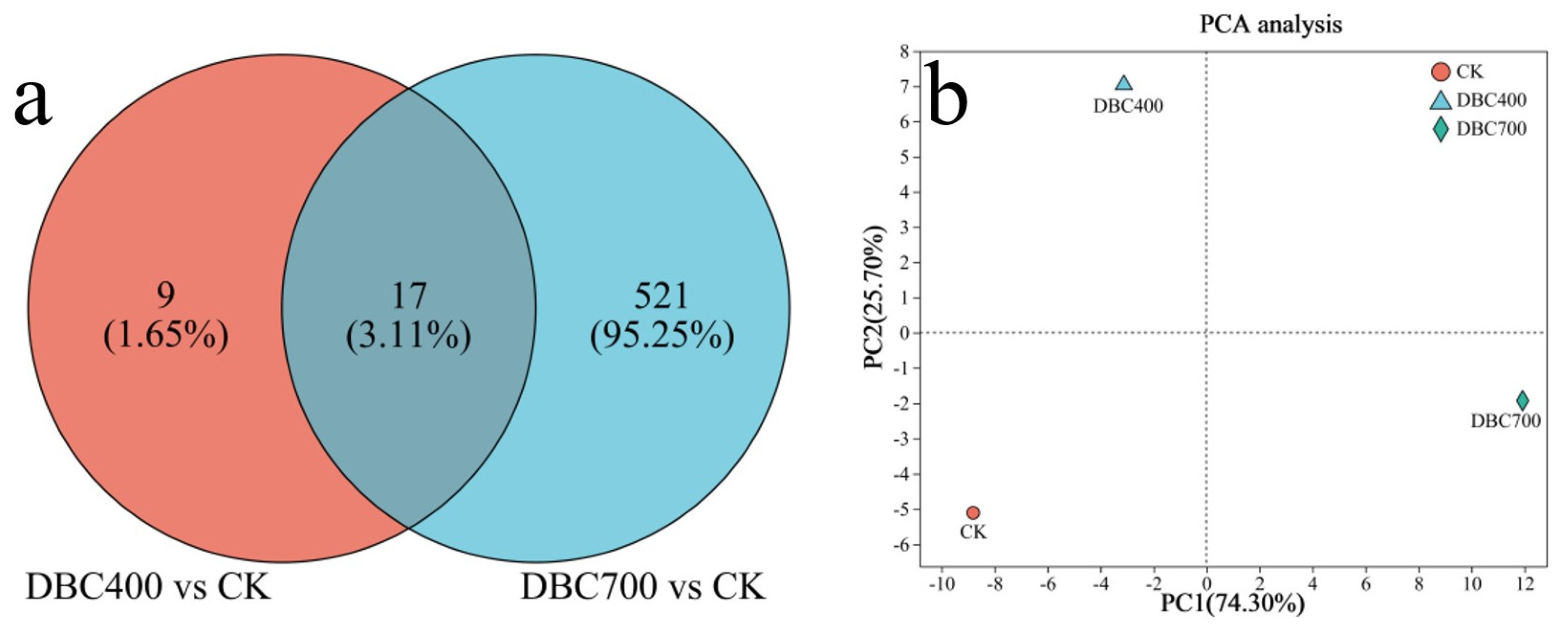

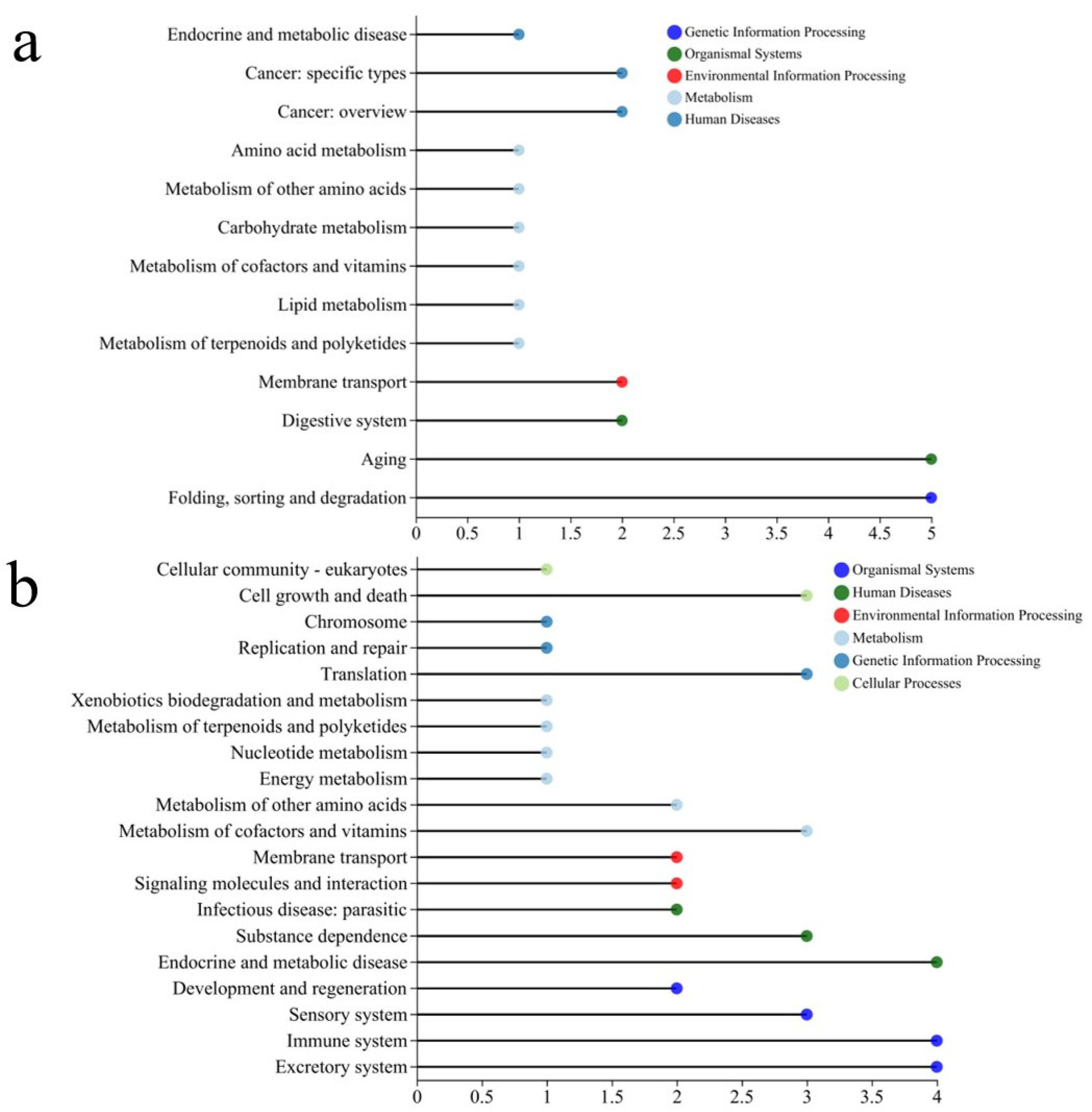
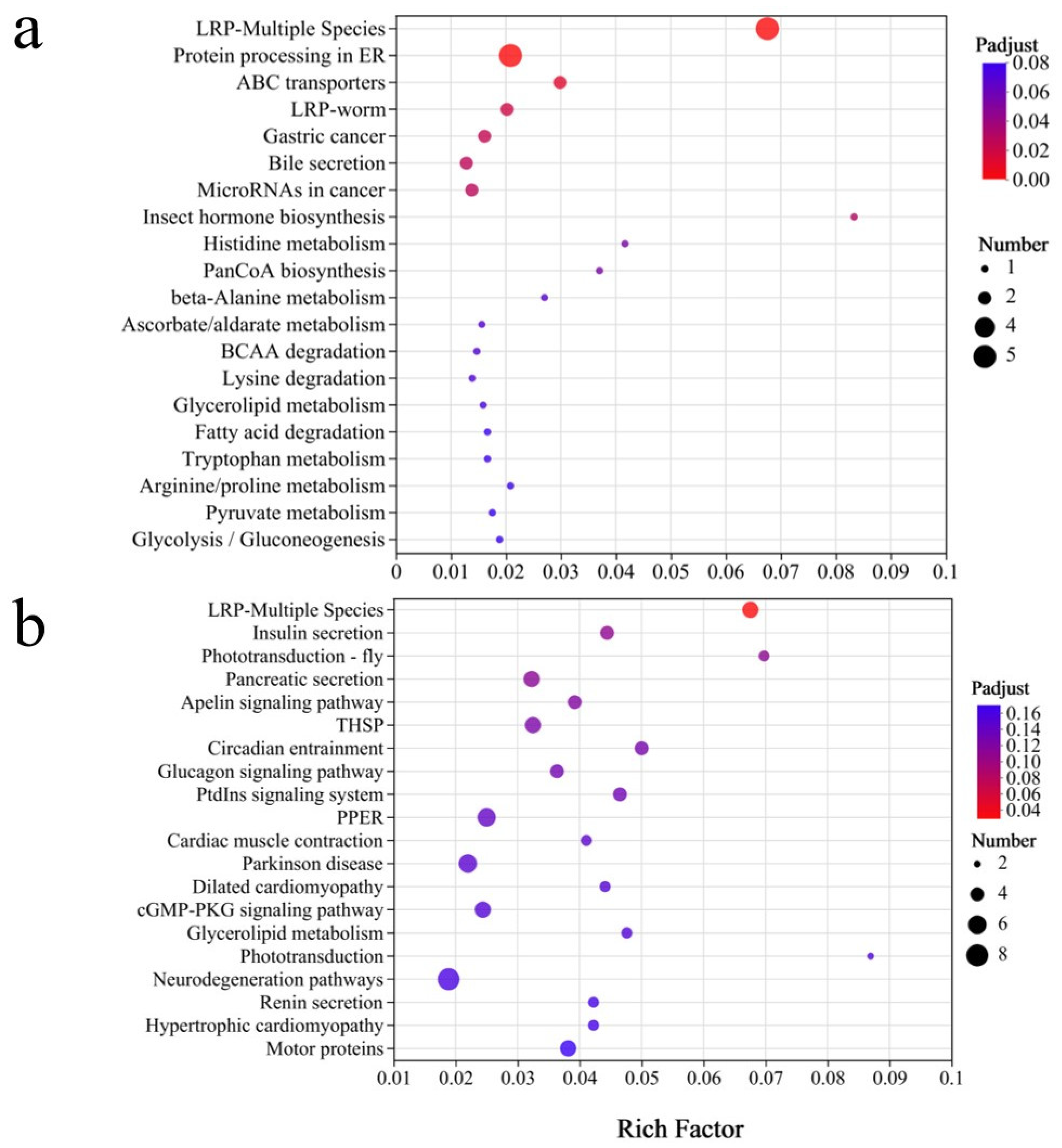
| Biochar | pH | Zeta Potential (mV) | Ash Content (%) | C (%) | H/C (%) | (N + O)/C (%) | DOC (mg/L) | Dx50 (μm) | SSA (m2/g) | EC (mS/cm) |
|---|---|---|---|---|---|---|---|---|---|---|
| DBC400 | 9.01 ± 0.11 | −25.13 ± 0.41 | 57.38 | 13.81 | 0.14 | 1.21 | 66.34 | 7.36 | 13.23 | 3.42 ± 0.25 |
| DBC700 | 9.31 ± 0.10 | −24.70 ± 0.83 | 69.62 | 14.2 | 0.10 | 1.13 | 17.63 | 0.10 | 29.68 | 3.89 ± 0.31 |
| Impact Category | DBC400 Effect | DBC700 Effect |
|---|---|---|
| Membrane Transport | membrane transport function and metabolism | transmembrane signaling and cellular communication |
| Energy Metabolism | carbohydrate and lipid metabolism | lipid metabolism and oxidative metabolism |
| Protein Stability | protein folding and degradation while enhancing cellular stress response | protein processing and signaling transduction |
| Lifespan Regulation | lifespan through energy metabolism and protein repair | lifespan via insulin signaling and nervous system regulation |
| Immune and Environmental Adaptation | nematode oxidative stress response and resistance | immune system and host interactions |
| Nervous and Motor Systems | No significant effects | nervous system and motor signaling |
| Metabolic Regulation | primarily lipid and carbohydrate metabolism | systemic metabolism and endocrine system |
Disclaimer/Publisher’s Note: The statements, opinions and data contained in all publications are solely those of the individual author(s) and contributor(s) and not of MDPI and/or the editor(s). MDPI and/or the editor(s) disclaim responsibility for any injury to people or property resulting from any ideas, methods, instructions or products referred to in the content. |
© 2025 by the authors. Licensee MDPI, Basel, Switzerland. This article is an open access article distributed under the terms and conditions of the Creative Commons Attribution (CC BY) license (https://creativecommons.org/licenses/by/4.0/).
Share and Cite
Wang, X.; Li, J.; Li, J.; Luo, L.; Li, G.; Ruan, W.; Zhang, G. The Impact of Dissolved Biochar on Oxidative Stress and Its Effect on the Virulence of Steinernema feltiae: Implications for Biocontrol Efficiency. Agriculture 2025, 15, 772. https://doi.org/10.3390/agriculture15070772
Wang X, Li J, Li J, Luo L, Li G, Ruan W, Zhang G. The Impact of Dissolved Biochar on Oxidative Stress and Its Effect on the Virulence of Steinernema feltiae: Implications for Biocontrol Efficiency. Agriculture. 2025; 15(7):772. https://doi.org/10.3390/agriculture15070772
Chicago/Turabian StyleWang, Xinrui, Jie Li, Jing Li, Lan Luo, Gang Li, Weibin Ruan, and Guilong Zhang. 2025. "The Impact of Dissolved Biochar on Oxidative Stress and Its Effect on the Virulence of Steinernema feltiae: Implications for Biocontrol Efficiency" Agriculture 15, no. 7: 772. https://doi.org/10.3390/agriculture15070772
APA StyleWang, X., Li, J., Li, J., Luo, L., Li, G., Ruan, W., & Zhang, G. (2025). The Impact of Dissolved Biochar on Oxidative Stress and Its Effect on the Virulence of Steinernema feltiae: Implications for Biocontrol Efficiency. Agriculture, 15(7), 772. https://doi.org/10.3390/agriculture15070772






